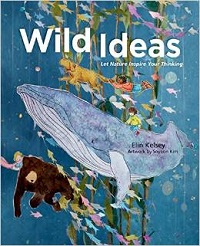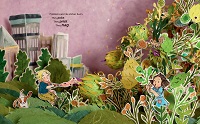| ________________
CM . . .
. Volume XXI Number . . . .June 19, 2015
excerpt:
The main theme of the book is that problems are a normal part of life. Everyone, including animals, has them. The trick is not to get bogged down by your problems, but rather, to use your imagination and creativity to find a solution. Dr. Kelsey uses her scientific background to show children how animals in the wild solve their own problems. For example, some problems require you to stop and make a plan, just like the orangutan; others require you to be innovative like the elephant, and some problems require you to learn from others, just like the squirrel. Ultimately, the lesson to be learned is that there is a wide range of solutions to life’s problems, and you just have to find the right solution for you. Wild Ideas is loaded with many great tidbits about wildlife, but readers should take note that this is not your traditional nonfiction book about animals. It is labeled as an “informational picture book”, which means that it reads like a traditional picture book that presents key facts throughout. Kelsey has done a great job of taking a very serious topic and making it relatable to children. The language is simple and succinct, and relates the key facts to children in an engaging manner. At the end, Kelsey also offers an author’s note which provides readers with more information about the science behind the book. I recommend using the author’s note as a starting point for children who would like to conduct more in depth research into any of the animals mentioned in the book. This picture book would not be complete without mentioning the breathtaking illustrations that are found throughout. The illustrations are, in fact, dioramas created by Soyeon Kim, “…who specializes in work that merges real-world materials, fine sketching, and painting techniques to produce three-dimensional dioramas” (Artist’s Biography). The result is an awe-inspiring rendition of the natural world. In fact, the images have a dream-like quality, combining bold colours and texture which makes the reader feel immersed in the book. As such, the text and illustrations match up perfectly, allowing nature’s wild ideas to come to life. I would recommend this book for anyone who not only loves nature, but who also likes to go a bit wild and think outside the box. Recommended.
Teresa Iaizzo is a Senior Library Assistant with the Toronto Public Library.
To comment on this title or this review, send mail to cm@umanitoba.ca.
Copyright © the Manitoba Library Association. Reproduction for personal use is permitted only if this copyright notice is maintained. Any
other reproduction is prohibited without permission.
CM Home |
Next Review |
(Table of Contents for This Issue - June 19, 2015.)
| Back Issues | Search | CM Archive
| Profiles Archive |

 And so begins Elin Kelsey’s Wild Ideas, a fun little book about the science behind problem solving. Labeling his book as an “informational picture book”, Dr. Kelsey, a science educator, aims to teach children about the various problem-solving styles found in the wild.
And so begins Elin Kelsey’s Wild Ideas, a fun little book about the science behind problem solving. Labeling his book as an “informational picture book”, Dr. Kelsey, a science educator, aims to teach children about the various problem-solving styles found in the wild.